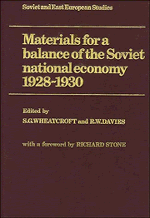Book contents
3 - A BRIEF HISTORY OF THE BALANCE OF THE NATIONAL ECONOMY
Published online by Cambridge University Press: 26 October 2011
Summary
In many respects the Materials for a Balance of the National Economy 1928–1930 represent one of the missing links in the story of the development of Soviet planning. For Soviet economic development to have achieved what it did there had to be a far more serious basis to the planning effort than appears from the available published literature. There was undoubtedly much chaos and unnecessary destruction, especially in agriculture, but nevertheless industry developed on an unparalleled scale; and this growth was based not on market pressure but on a planning process covering an increasingly complex economy.
The planning process was more of a constant administrative process than a genuine attempt to fulfil the targets in specific planning documents, as Professor Zaleski has recently pointed out. But more serious attempts were made to coordinate the separate elements in the plan than appears in most Western accounts of the Soviet planning process of the time.
The present document provides us for the first time with an opportunity to study a major attempt to uncover inter-branch and inter-sector relationships in the economy. It was produced in a limited edition of 500 copies, marked ‘For official use only’, and circulated among senior planners and officials in the summer of 1932. This was a crucial moment at the end of the first five-year planning period, when the second five-year plan was still under discussion.
- Type
- Chapter
- Information
- Publisher: Cambridge University PressPrint publication year: 1985
- 3
- Cited by



